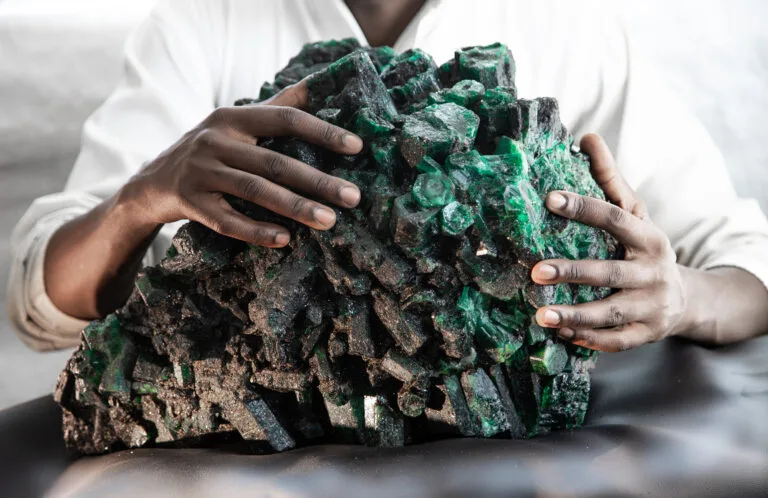
Discovered at the Kagem emerald mine in Zambia in March 2020, the Kafubu Cluster is a colossal cluster of emeralds. Close inspection of the 37,555-gram (187,775 carat) cluster reveals that it contains very little matrix or other minerals, meaning the piece is almost entirely made up of emeralds, which, given its sheer size and formation, makes this a very rare find indeed.
While Zambia celebrates its newfound dominance in emerald production, the inability of local companies to purchase these precious stones raises concerns.
Lusaka, Dec. 16 – In a significant development, Zambia has claimed the top position in the global emerald production, surpassing Chile. However, this victory in the gemstone industry is marred by a disturbing paradox.
Value addition companies within Zambia are unable to purchase the precious stones produced in their own land. The reasons for this startling conundrum and its implications on the Zambian economy and gemstone market are yet to be explored.
Also Read: We don’t have a capable leader to mobilise national wealth – Nawakwi.
“What the country earns from the mining sector alone is several times more than the $6.3bn debt restructuring mechanism!”
◾Emerald Production and the Local Challenge
While Zambia celebrates its newfound dominance in emerald production, the inability of local companies to purchase these precious stones raises concerns.
The situation presents a stark contradiction that could hamper the growth of the local gemstone industry. The exact reasons behind this issue are not immediately apparent, but the consequences might include missed opportunities for local economic growth, job creation, and technological advancement in the gemstone processing sector.
Also Read: Zambia is not benefitting from its mineral resources – Amb. Mwamba.
“71Kg of emralds roughly gives you $188m. Zambia produces about 7,100Kg a year!”
◾Lifezone Metals’ Role and Future Endeavors
Lifezone Metals Limited, a key player in Zambia’s emerald industry, has achieved this feat by collaborating with a subsidiary of Glencore plc. The collaboration has a phased implementation plan, including the construction of a commercial scale Platinum Group Metals (PGMs) recycling facility.
This project aims to recover PGMs from responsibly sourced spent automotive catalytic converters using Lifezone’s Hydromet technology. This method claims to be more efficient and generates fewer emissions than traditional methods.
Lifezone’s efforts showcase a greener, more sustainable approach to gemstone production, which could reshape the industry’s future.
◾The Fate of Zambia’s Koffiefontein Diamond Mine
Meanwhile, in another significant development, South Africa’s Petra Diamonds has signed a non-binding deal regarding the sale of its Koffiefontein diamond mine in Zambia.
The mine is scheduled to exhaust its reserves by 2025 and was put on care and maintenance in November 2022. If the potential sale falls through, Petra plans to decommission, rehabilitate, and close the mine, ending a significant chapter in Zambia’s diamond mining history. This potential exit might also signal shifting dynamics in the global diamond market.
About Woodpecker’s Digest: We are an online portal for analytical commentaries on topical issues of national interest and for articles on personal development and health! Journalism maintains democracy. It is a great tool for progressive social change! We, therefore, see it as our job to put constant pressure on our leaders until we get answers.
©2023 Woodpecker’s Digest.
Putting news into perspective







